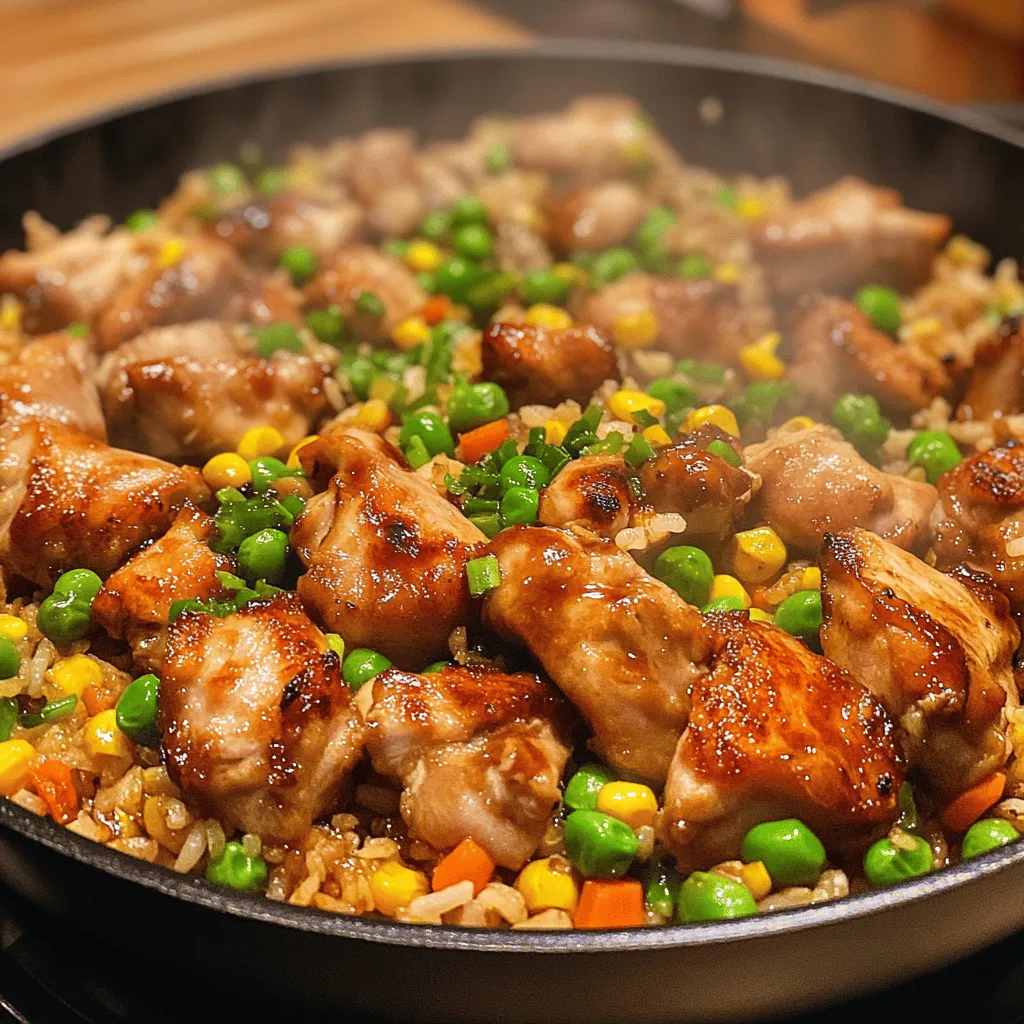Introduction
If you’ve ever dined at a hibachi restaurant, you know that the experience is as much about the showmanship as it is about the food. Hibachi cooking, with its sizzling sounds, vibrant flames, and theatrical presentations, has captured the hearts and palates of many. Originating from Japan, hibachi refers to both the cooking style and the grill used to prepare the food. Today, we’ll focus on a delightful dish that embodies the essence of hibachi cooking: Hibachi Chicken with Fried Rice.
This dish is not only a crowd-pleaser but also incredibly versatile, making it perfect for quick weeknight dinners or impressing guests during gatherings. With its tender, flavorful chicken and savory fried rice, this recipe is sure to become a staple in your culinary repertoire. In this article, you will learn about the hibachi cooking method, the key ingredients that make this dish shine, and step-by-step instructions for marinating the chicken to ensure maximum flavor. Get ready to elevate your home cooking with this delicious hibachi-inspired meal!
Understanding Hibachi Cooking
Hibachi cooking is characterized by its high heat and fresh ingredients, resulting in vibrant flavors and delightful textures. The term ‘hibachi’ translates to ‘fire bowl’ in Japanese, referring to the traditional grill used in this style of cooking, which is often fueled by charcoal or gas. The technique involves cooking food quickly over an open flame, allowing the natural flavors of the ingredients to shine through.
The origins of hibachi trace back to Japan, where it was initially a method of preparing food for families using simple ingredients and basic grills. Over the years, hibachi has evolved into a popular restaurant dining experience, particularly in North America, where chefs perform dazzling tricks while grilling meats and vegetables right in front of the diners.
One of the key elements of hibachi cooking is the emphasis on presentation. The vibrant colors of the ingredients, the artful stacking of vegetables, and the dramatic flair of cooking create an experience that is as much visual as it is culinary. This recipe for Hibachi Chicken with Fried Rice aims to bring that experience into your home, allowing you to impress both your family and friends with a restaurant-quality meal.
Ingredients Breakdown
Before diving into the cooking process, let’s familiarize ourselves with the essential ingredients that will make up our Hibachi Chicken and Fried Rice. Using high-quality, fresh ingredients is crucial for achieving that authentic hibachi flavor.
Key Ingredients for Hibachi Chicken
1. Chicken: The star of our dish is boneless, skinless chicken breasts. This cut is ideal because it cooks quickly and remains juicy when prepared at high temperatures. Additionally, using chicken breasts allows for easy slicing and serving.
2. Soy Sauce: Quality soy sauce is essential for adding depth and umami to our dish. It not only enhances the flavor of the chicken but also contributes to the overall seasoning of the fried rice. Opt for a low-sodium soy sauce if you’re watching your salt intake, but make sure to choose a brand that uses traditional fermentation methods for the best flavor.
3. Garlic and Ginger: These two aromatics are staples in Asian cuisine and bring a warm, fragrant flavor profile to the dish. Garlic is known for its robust and pungent taste, while ginger adds a zesty and slightly sweet note. Both ingredients also offer numerous health benefits, including anti-inflammatory properties and digestive support.
4. Sesame Oil: A little goes a long way with sesame oil. This oil adds a nutty flavor and richness to the dish, enhancing the overall taste of the chicken and fried rice. It’s best to use toasted sesame oil for its intense flavor.
5. Black Pepper and Green Onions: Freshly cracked black pepper adds a subtle heat to the dish, while green onions provide a fresh and crisp garnish. The green onions not only enhance the flavor but also add a pop of color, making the dish visually appealing.
Ingredients for Fried Rice
1. Jasmine Rice: For the fried rice, we recommend using day-old jasmine rice. Freshly cooked rice tends to be too moist and sticky, which can lead to clumping. Day-old rice has had time to dry out in the refrigerator, allowing for that perfect fluffy texture. If you don’t have leftover rice, cook your jasmine rice ahead of time and let it cool before using it in the recipe.
2. Eggs: Eggs are a vital component of fried rice, providing both flavor and nutrition. They add richness to the dish and help bind the ingredients together. Beating the eggs before adding them to the rice ensures an even distribution throughout the dish.
3. Mixed Vegetables: Incorporating a mix of vegetables not only adds color and texture but also boosts the nutritional value of the meal. Common options include peas, carrots, and bell peppers, but feel free to get creative with whatever vegetables you have on hand.
4. Seasonings: Achieving the right balance of flavors is crucial in fried rice. In addition to soy sauce, a touch of sesame oil enhances the taste. Other seasonings like salt, black pepper, and garlic powder can also be added to suit your preferences.
Marinating the Chicken
Now that we’ve covered the key ingredients, let’s dive into the first crucial step in creating our Hibachi Chicken: marinating the chicken. Marinating not only infuses the chicken with flavor but also helps to tenderize the meat, making it juicy and delicious.
Step-by-Step Guide to Marinating the Chicken
1. Prepare the Marinade: In a mixing bowl, combine 1/4 cup of soy sauce, 2 tablespoons of sesame oil, 2 cloves of minced garlic, and 1 tablespoon of grated ginger. Whisk these ingredients together until well blended. This marinade will serve as the flavor base for our chicken.
2. Slice the Chicken: Take your boneless, skinless chicken breasts and slice them into bite-sized pieces or thin strips. Cutting the chicken this way allows it to absorb the marinade more effectively and ensures even cooking.
3. Marinate the Chicken: Place the sliced chicken into a resealable plastic bag or a shallow dish. Pour the marinade over the chicken, making sure every piece is well coated. Seal the bag or cover the dish, then refrigerate for at least 30 minutes. For even better results, marinate for 1 to 2 hours to allow the flavors to penetrate deep into the meat.
4. Preheat the Grill or Skillet: While the chicken is marinating, preheat your grill or stovetop skillet over high heat. If you’re using a grill, ensure it’s well-oiled to prevent sticking. If cooking on a skillet, you can add a small amount of oil to help achieve that desirable sear.
By marinating the chicken properly, you set the stage for a dish that bursts with flavor in every bite. The combination of soy sauce, garlic, and ginger creates an aromatic base that complements the natural taste of the chicken beautifully.
In the next section, we will discuss how to cook the chicken and prepare the fried rice, bringing all these delicious elements together for a satisfying meal. Stay tuned for the continuation of this flavorful hibachi-inspired dish!

Importance of Marinating Time and Techniques to Enhance Taste
Marinating is a crucial step in preparing Hibachi Chicken, as it infuses the meat with flavor and tenderness. For optimal results, allow the chicken to marinate for at least 30 minutes, though longer times—up to 4 hours or even overnight—can enhance the flavor significantly. The key ingredients in the marinade typically include soy sauce, garlic, ginger, and a touch of sesame oil, each playing a vital role in building layers of taste.
The marinating process affects not only the flavor but also the texture of the chicken. The acidity from ingredients like soy sauce helps break down proteins, making the chicken more tender and juicy when cooked. Additionally, marinating at low temperatures helps the flavors penetrate deeper into the meat. For best practices, ensure that the chicken is coated evenly in the marinade and stored in the refrigerator during this time to maintain food safety.
Cooking the Hibachi Chicken
Once the chicken has marinated, it’s time to cook it to perfection. For this recipe, you can use either a skillet or a wok, depending on what you have available. A wok is ideal for high-heat cooking and allows for even distribution of heat, which is essential for achieving that authentic Hibachi flavor.
1. Preheat Your Cooking Surface: Begin by preheating your skillet or wok over medium-high heat. This is critical as a hot cooking surface will help sear the chicken quickly, locking in juices.
2. Add Oil: Once the pan is hot, add a tablespoon of vegetable oil or sesame oil. The oil should shimmer immediately; if it doesn’t, wait a bit longer before adding the chicken.
3. Cook the Chicken: Remove the chicken from the marinade, letting any excess drip off. Place the chicken in the hot pan in a single layer. Avoid overcrowding the pan, as this can lead to steaming instead of searing. Cook the chicken for about 5-7 minutes on one side without moving it, allowing it to develop a golden-brown crust. Flip the pieces and cook for an additional 5-7 minutes until fully cooked through and the internal temperature reaches 165°F.
4. Rest the Chicken: Once cooked, remove the chicken from the pan and let it rest for a few minutes before slicing. This resting period allows the juices to redistribute throughout the meat, ensuring every bite is juicy and flavorful.
Preparing the Fried Rice
Fried rice is a classic side that perfectly complements Hibachi Chicken. It’s essential to use cooked rice that has been chilled, preferably overnight, as this helps prevent clumping and ensures that the grains fry up nicely.
1. Gather Your Ingredients: For the fried rice, you will need:
– 3 cups of chilled, day-old rice
– 2 tablespoons of vegetable oil
– 2 eggs
– 1 cup of mixed vegetables (carrots, peas, and corn)
– 3 green onions, chopped
– Soy sauce, to taste
– Salt and pepper, to taste
2. Scramble the Eggs: In a large skillet or wok, heat a tablespoon of oil over medium heat. Crack the eggs into the pan and scramble them gently until fully cooked, about 2 minutes. Remove the eggs and set them aside.
3. Stir-Fry the Vegetables: In the same pan, add another tablespoon of oil. Add the mixed vegetables and stir-fry for about 3-4 minutes until they are tender but still vibrant in color.
4. Add the Rice: Next, add the chilled rice to the pan. Break up any clumps with a spatula and ensure the rice is evenly coated with oil. Stir-fry for 5-7 minutes, allowing the rice to get a little crispy.
5. Combine Ingredients: Once the rice is warmed through, add the scrambled eggs back into the pan along with the chopped green onions. Pour in soy sauce to taste, and season with salt and pepper. Stir everything together for another minute or two, allowing the flavors to meld.
Combining the Dishes
To create the ultimate dining experience, it’s important to combine the Hibachi Chicken and fried rice thoughtfully. Here’s how to do it effectively:
1. Mixing Flavors: In a large serving bowl or platter, combine the sliced Hibachi Chicken with the fried rice. This allows each bite to capture the essence of both dishes.
2. Keep It Warm: If you need to keep the dish warm before serving, cover it with aluminum foil or place it in a low oven (about 200°F). This will prevent the food from cooling down too much while you prepare any additional sides or drinks.
Presentation and Serving Suggestions
The way you present your Hibachi Chicken with Fried Rice can greatly enhance its appeal. Here are some ideas to make your dish visually striking:
1. Garnishing: Sprinkle additional chopped green onions over the top for a fresh pop of color. You can also add some sesame seeds for an extra crunch.
2. Serving Style: Serve the dish family-style in a large bowl or on a platter, allowing guests to help themselves. Alternatively, plate individual servings for a more formal presentation.
3. Pairing Suggestions: To complement the flavors of Hibachi Chicken, consider serving it with a fresh cucumber salad or miso soup. For beverages, iced green tea or a light Japanese beer can enhance the meal.
4. Cultural Aspect: Sharing a Hibachi meal is often associated with celebration and communal dining. Embrace this aspect by gathering family and friends around the table, encouraging conversation and enjoyment of the meal together.
Nutritional Information
When considering the nutritional benefits of Hibachi Chicken with Fried Rice, it’s important to recognize the balance of protein, carbohydrates, and vegetables. Here’s a breakdown of key nutrients:
– Calories: A serving typically contains around 400-500 calories, depending on the portion sizes and specific ingredients used.
– Protein: The chicken provides a substantial amount of protein, making it a filling option for any meal.
– Vitamins and Minerals: The inclusion of mixed vegetables adds vitamins A and C, as well as fiber, contributing to a well-rounded dish.
For those looking to make dietary adjustments, consider using brown rice for added fiber, or substituting the chicken with tofu or another plant-based protein. Reducing the amount of soy sauce can lower sodium levels, making the dish healthier without sacrificing taste.
Conclusion
Making Hibachi Chicken with Fried Rice at home is not only a rewarding culinary endeavor but also an opportunity to create lasting memories with family and friends. The joy of gathering around a delicious meal can bring people closer together, and preparing this dish allows you to explore the vibrant flavors of Japanese cuisine right in your kitchen.
Don’t hesitate to experiment with variations of the recipe—try adding different vegetables, spices, or proteins to suit your taste. The beauty of home-cooked meals lies in their adaptability and the personal touch you can bring to each dish. Embrace the process, enjoy the flavors, and most importantly, share your creations with those you love. Happy cooking!



